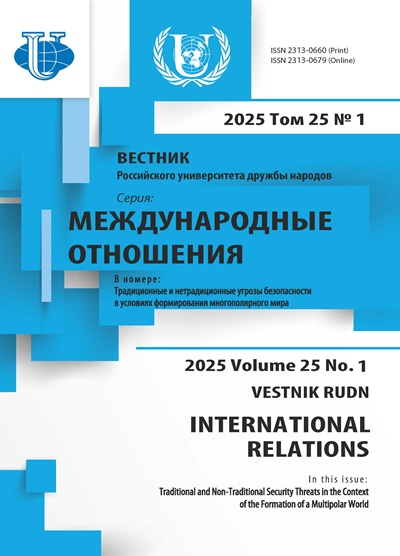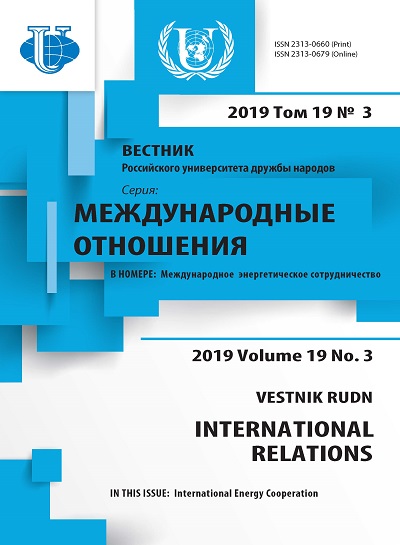Creation of Thermonuclear Experimental Reactor ITER as an Example of International Scientific and Technical Cooperation in Energy Sector
- Authors: Degterev A.K.1
-
Affiliations:
- Sevastopol State University
- Issue: Vol 19, No 3 (2019): International Energy Cooperation
- Pages: 480-489
- Section: INTERNATIONAL EDUCATIONAL COOPERATION
- URL: https://journals.rudn.ru/international-relations/article/view/22597
- DOI: https://doi.org/10.22363/2313-0660-2019-19-3-480-489
Cite item
Full Text
Abstract
The article analyses the prospects for the implementation of the largest international scientific and technical project (“mega-science” project) ITER of controlled thermonuclear fusion. With the depletion of fossil fuel reserves, the role of new energy sources, including those that have not yet been developed, is increasing. Due to the extremely high costs and ambitious scientific goals facing the project, its practical implementation and funding are possible in close international scientific and technical cooperation in the energy sector. The role of an international group of seven participants (Russia, the EU, Japan, China, India, the Republic of Korea and the USA) in the creation of laboratory fusion facilities is noted. The choice of a Tokamak-type design for the ITER international reactor being built in France is the recognition of Russian’s decisive role. The article reveals the main parameters of international partnership, the specification of which is carried out on a regular basis at ITER coordination meetings with the participation of representatives of national ITER agencies. The parameters of interaction with scientific institutions of countries that are not members of the consortium are given. The evolution of the project since its launch in 1985 as a joint Soviet-American initiative is shown. Four options for the initial placement of the reactor are considered: in Spain, France, Canada and Japan. The features of the organizational and legal regulation of the international consortium for the management of ITER are disclosed, including the establishment of the ITER International Organization for Thermonuclear Energy for the joint implementation of the ITER project in 2006. The role of the in-kind contribution of countries in international projects in the exchange of unique world-class technologies is discussed. The main goals set by the countries participating in the project and the time horizons for their practical achievement are listed. The parameters of Russia's participation in the project are given, the prospects for further cooperation in this area are evaluated. Particular attention is paid to the peculiarities of the political interaction of the participating countries, as well as to the intermediate results already achieved during the implementation of the ITER project.
About the authors
Andrey Kharitonovich Degterev
Sevastopol State University
Author for correspondence.
Email: degsebal@mail.ru
PhD in Physical and Mathematical Science, Dr. of Science, Professor, Department of Radioecology and Environmental Safety, Institute of Nuclear Energy and Industry
Sevastopol, Russian FederationReferences
- A Review of the DOE Plan for U.S. Fusion Community Participation in the ITER Program. (2009). National Academy of Sciences. Washington: The National Academic Press.
- Arutyunov, V.S. & Lapidus, A.L. (2005). The Role of Gas Chemistry in World Energy. Herald of the Russian Academy of Sciences, 75 (8), 683—693. (In Russian).
- Belotsky, S.D. (2012). IRENA and ITER as the Regulating Forces of International Relationships in the Sphiere of Alternative Energy. RUDN Journal of Law, 4, 242—252. (In Russian).
- Cho, A. (2012). Bigger Contribution to ITER Erodes Domestic Fusion Program. Science, 335 (6071), 901—902. doi: 10.1126/science.335.6071.901
- Claessens, M. (2020). ITER, the Giant Fusion Reactor: Bringing a Sun to Earth. Berlin: Springer.
- Clery, D. & Bosch, X. (2003). E.U. Puts France in Play for Fusion Sweepstakes. Science, 302 (5651), 1640. doi: 10.1126/science.302.5651.1640
- Clery, D. & Normile, D. (2004). Cadarache: More than Just a Candidate Site. Science, 306 (5702), 1669. doi: 10.1126/science.306.5702.1669a
- Clery, D. & Normile, D. (2005). ITER Rivals Agree to Terms; Site Said to Be Cadarache. Science, 308 (5724), 934—935. doi: 10.1126/science.308.5724.934a
- Clery, D. (2006). ITER’s $12 Billion Gamble. Science, 314 (5797), 238—242. doi: 10.1126/science.314.5797.238
- Coordination Meeting of the Leadership of the ITER International Organization and Representatives of National ITER Agencies (2008). Issues of Atomic Science and Technology. Series: Thermonuclear Fusion, 4, 101. (In Russian).
- Edler, J. (2012). Toward Variable Funding for International Science. Science, 338 (6105), 331—332. doi: 10.1126/science.1221970
- Glanz, J. & Lawler, A. (1998). Planning a Future without ITER. Science, 279 (5347), 20—21. doi: 10.1126/science.279.5347.20 Goldston, R. (2011). Anatomy of Fusion: the Reactor of the Future. World Policy Journal, 28 (3), 40—43.
- Gorlova, E.N. & Tkachenko, R.V. (2019). The Concept of Projects of “Megasience” Class Projects: the Case of ITER and FAIR Installations. Actual Problems of Russian Law, 5, 205—213. (In Russian). DOI: https://doi.org/10.17803/19941471.2019.102.5.205-213
- ITER Chronicle (2012). Questions of Atomic Science and Technology. Series: Thermonuclear Fusion, 1, 72. (In Russian). Ivanov, D.A., Lukyantsev, D.S., Klykov, A.D. & Vasiliev, S.P. (2018). International Thermonuclear Experimental Reactor —
- Project for the Development of Future Power Engineering All the World. Scientific Horizons, 11, 98—111. (In Russian). Korzhavin, V.M. (2003). The Results of the 8th Round of Negotiations of the Delegations of the Russian Federation, Euratom,
- Canada, Japan, China and the United States on the Preparation of an Agreement on the Joint Implementation of the ITER Project. Issues of Atomic Science and Technology. Series: Thermonuclear Fusion, 1, 95—98. (In Russian).
- Makarov, A.A. & Fortov, E.E. (2004). The Development Trend of World Energy and the Energy Strategy of Russia. Herald of the Russian Academy of Sciences, 74 (6), 195—208. (In Russian).
- Malakoff, D., Cho, A. & Service, R. (2003). ITER Tops DOE’s List of Next Big Science Projects. Science, 302 (5648), 1126— 1127. doi: 10.1126/science.302.5648.1126
- Matsuda, Sh. & Tobita, K. (2013). Evolution of the ITER program and prospect for the next-step fusion DEMO reactors: status of the fusion energy R&D as ultimate source of energy. Journal of Nuclear Science and Technology, 50 (4). 321—345.
- McKray, W.P. (2010). ‘Globalization with hardware’: ITER’s fusion of technology, policy, and politics. History and Technology, 26 (4), 283—312. doi: 10.1080/07341512.2010.523171
- Motojima, O. & Travis, J. (2010). Fresh Start for Fusion Project as New Leader Shakes Up Management. Science, 328 (5992), 616—617. doi: 10.1126/science.329.5992.616-a
- Normile, D. & Kondro, W. (2001). Canada Bids to Host International Reactor. Science, 292 (5525), 2240. doi: 10.1126/science.292.5525.2240
- Petrov, N.P., Afanasyev, V.I., Mukhin, E.E. & Shevelev, A.E. (2018). Fizteh — to International Thermonuclear Reactor. Nature, 9, 12—21. (In Russian).
- Ramamurthy, V.S. (2011). Global Partnerships in Scientific Research and International Mega-Science Projects. Current Science, 100 (12), 1783—1785.
- Rutherford, P. & Baker, Ch. (1996). The ITER Project. Science, 272 (5259), 181—182. doi: 10.1126/science.272.5259.181a
- Seife, Ch. & Normile, D. (2003). United States Rejoins International Fusion-Research Project. Science, 299 (5608), 801—802. doi: 10.1126/science.299.5608.801a
- Seife, Ch. (2002). Energy Panel Asks U.S. to Rejoin ITER. Science, 297 (5589), 1977. doi: 10.1126/science.297.5589.1977a
- Shore, B. & Cross, B. (2003). Management of Large-Scale International Science Projects: Politics and National Culture. Engineering Management Journal, 15 (2), 25—34.
- The Signing of an International Agreement on the Construction of an International Thermonuclear Experimental Reactor ITER. (2007). Questions of atomic science and technology. Series: Thermonuclear Fusion, 1, 92—93. (In Russian).
- Thermonuclear Fusion is the Design of the Century. Interview with Krasilnikov A.V. (2014). In the World of Science, 2, 26—29. (In Russian).
- Velikhov, E.P. & Mirnov, S.V. (2009). The First ITER Fusion Reactor Reached the Finish Line. Herald of the Moscow Power Engineering Institute, 4, 11—15. (In Russian).
- Velikhov, E.P. (Eds.). (2005). Energy of the Future. International ITER Project. Moscow: UTS-Tsentr publ. (In Russian).











